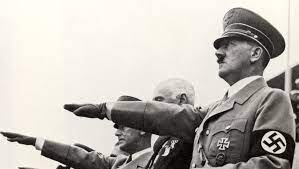1936 Olympic Games, Berlin
- Comentários desativados em 1936 Olympic Games, Berlin
Olympic Games of 1936, were held in Berlin, capital of Germany, between 1 and 6 August, suffer Nazi influence.
The Nazi regime used the Olympic Games to charm foreign spectators and journalists with the image of a peaceful and tolerant Germany. In 1933, in the United States, Great Britain, France, Sweden, Czechoslovakia and Holland, there were movements calling for the cancellation of this event, but Jewish athletes from different countries decided to boycott the Berlin Games. But in December 1935, after the United States Amateur Athletes Union decided to participate, other countries followed suit and boycott moves failed.
As stated in the previous paragraph, there was an attempt to boycott when Avery Brundage argued that there was no place for politics in sport. However, when Judge Jeremiah Mahoney, president of the Amateur Athletic Union, decided to help in the boycott by leading efforts in the Olympics, he would indicate a guarantee of USA participation to Hitler’s Nazi regime.
Jewish athletes from different countries also decided, individually, to boycott the Games in Berlin. However, Hitler authorized a brief relaxation of anti-Semitic activities, which included the removal of signs barring Jews from public places. The Games were a form of propaganda with guaranteed success for the Nazis, which supported the idea of a Germany different from reality.
The torch relay had its first occurrence in 1936, on it there was a bell where it was written “Ich rufe die Jugend der Welt” (I call the youth of the world), with that the Nazi regime presented itself peaceful and open to the world. The 3,422 athletes who participated in these Olympics ran 1 km with it, starting from Olympia-Greece.
The Olympic Games were opened by Hitler on August 1, 1936, where the Nazis aimed to convey a positive image about his regime, but the center of attention turned out to be Jesse Owens, a black athlete and great grandson of slaves. Jesse has 4 gold medals due to his performance in 4 disciplines: 100m, 200m, 4x100m relay and long jump. Even after all his excellence in conducting the tests, it was taken by Hitler as an unacceptable insult, because “they are essentially animals, therefore stronger than the “civilized whites”, which made Hitler withdraw from the stadium and not to greet the medalist.
Thus, it is possible to observe how Nazism influenced the 1936 Olympics, to the point of failing to carry out the greetings because of a person’s skin color and “race”. We believe that, at the moment, it is extremely important to be aware of all these absurd actions so that they do not happen again.

participants
A influência nazista nos Jogos Olímpicos de 1936, Berlim
Os Jogos Olímpicos de 1936, realizados em Berlim, capital da Alemanha, entre os dias 1 e 6 de agosto, sofrem influência nazista.
O regime nazista usou os Jogos Olímpicos para encantar os espectadores e jornalistas estrangeiros com a imagem de uma Alemanha pacífica e tolerante. Em 1933, nos Estados Unidos, Grã-Bretanha, França, Suécia, Tchecoslováquia e Holanda, havia movimentos pedindo o cancelamento da prova, mas atletas judeus de diversos países decidiram boicotar os Jogos de Berlim. Mas em dezembro de 1935, depois que o Sindicato de Atletas Amadores dos Estados Unidos decidiu participar, outros países seguiram o exemplo e os boicotes falharam.
Conforme declarado no parágrafo anterior, houve uma tentativa de boicote quando Avery Brundage argumentou que não havia lugar para a política no esporte. No entanto, quando o juiz Jeremiah Mahoney, presidente da União Atlética Amadora, decidiu ajudar no boicote liderando os esforços nas Olimpíadas, ele indicaria uma garantia de participação dos EUA ao regime nazista de Hitler.
Atletas judeus de diferentes países também decidiram, individualmente, boicotar os Jogos de Berlim. No entanto, Hitler autorizou um breve relaxamento das atividades anti-semitas, que incluía a remoção de placas que impediam os judeus de entrar em locais públicos. Os Jogos eram uma forma de propaganda com sucesso garantido para os nazistas, que apoiavam a ideia de uma Alemanha diferente da realidade.
O revezamento da tocha teve sua primeira ocorrência em 1936, nele havia um sino onde estava escrito “Ich rufe die Jugend der Welt” (eu chamo a juventude do mundo), com isso o regime nazista se apresentou pacífico e aberto ao mundo. Os 3.422 atletas que participaram dessas Olimpíadas correram 1 km com ela, partindo de Olímpia-Grécia.
Os Jogos Olímpicos foram abertos por Hitler em 1º de agosto de 1936, onde os nazistas pretendiam transmitir uma imagem positiva sobre seu regime, mas o centro das atenções acabou sendo Jesse Owens, um atleta negro e bisneto de escravos. Jesse tem 4 medalhas de ouro devido ao seu desempenho em 4 modalidades: 100m, 200m, revezamento 4x100m e salto em distância. Mesmo depois de toda sua excelência na condução dos testes, isso foi tomado por Hitler como um insulto inaceitável, pois “são essencialmente animais, portanto mais fortes que os“ brancos civilizados ”, o que fez Hitler se retirar do estádio e não saudar o medalhista.
Assim, é possível observar como o nazismo influenciou as Olimpíadas de 1936, a ponto de deixar de realizar os cumprimentos por causa da cor da pele e da “raça” de uma pessoa. Acreditamos que, no momento, é extremamente importante estar atento a todas essas ações absurdas para que não voltem a acontecer.
Authors: Amanda Slivak Petroski, Débora de Paula Lacerda, Gabriella Mariano do Carmo, Heloísa de Souza Malcher e Maria Luíza Uliana Dias.
Autores: Amanda Slivak Petroski, Débora de Paula Lacerda, Gabriella Mariano do Carmo, Heloísa de Souza Malcher e Maria Luíza Uliana Dias.
Fontes Imagem: https://encyclopedia.ushmm.org/images/large/5f5e6c9e-52ba-4841-9d66-14adc36d6971.jpg.pagespeed.ce.SpEVi3wDcK.jpg / Acesso em 06 de dezembro de 2021
Fonte Imagem: https://encrypted-tbn0.gstatic.com/images?q=tbn:ANd9GcTTjbqjYUA2lV6-3-u1J-xP2VcB1U5V4nMlqA&usqp=CAU / Acesso em 06 de dezembro de 2021

